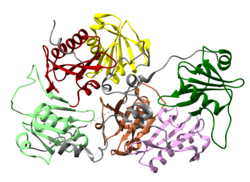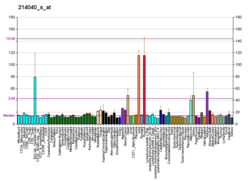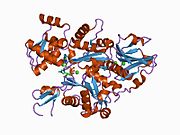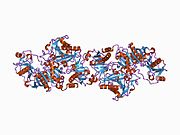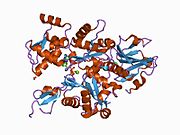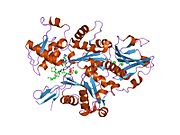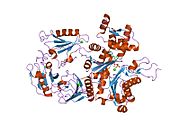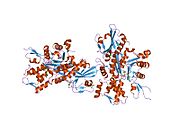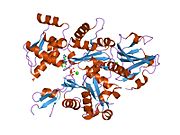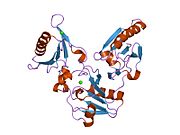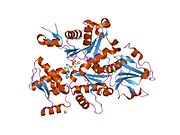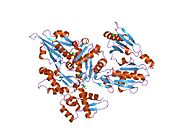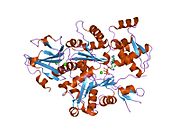Gelsolin
Gelsolinis anactin-binding protein that is a key regulator of actin filament assembly and disassembly. Gelsolin is one of the most potent members of the actin-severing gelsolin/villinsuperfamily, as it severs with nearly 100% efficiency.[4][5]
Cellular gelsolin, found within thecytosolandmitochondria,[6]has a closely related secreted form,Plasma gelsolin,that contains an additional 24 AA N-terminal extension.[7][8]Plasma gelsolin's ability to severactin filamentshelps the body recover from disease and injury that leaks cellular actin into the blood. Additionally it plays important roles in hostinnate immunity,activatingmacrophagesand localizing ofinflammation.
Structure[edit]
Gelsolin is an 82-kD protein with six homologous subdomains, referred to as S1-S6. Each subdomain is composed of a five-strandedβ-sheet,flanked by twoα-helices,one positioned perpendicular with respect to the strands and one positioned parallel. The β-sheets of the threeN-terminalsubdomains (S1-S3) join to form an extended β-sheet, as do the β-sheets of theC-terminalsubdomains (S4-S6).[9]
Regulation[edit]
Among thelipid-binding actin regulatory proteins, gelsolin (likecofilin) preferentially binds polyphosphoinositide (PPI).[10]The binding sequences in gelsolin closely resemble the motifs in the other PPI-binding proteins.[10]
Gelsolin's activity is stimulated by calcium ions (Ca2+).[5]Although the protein retains its overall structural integrity in both activated and deactivated states, the S6 helical tail moves like a latch depending on the concentration of calcium ions.[11]The C-terminal end detects the calcium concentration within the cell. When there is no Ca2+present, the tail of S6 shields the actin-binding sites on one of S2's helices.[9]When a calcium ion attaches to the S6 tail, however, it straightens, exposing the S2 actin-binding sites.[11]The N-terminal is directly involved in the severing of actin. S2 and S3 bind to the actin before the binding of S1 severs actin-actin bonds and caps the barbed end.[10]
Gelsolin can be inhibited by a local rise in the concentration ofphosphatidylinositol (4,5)-bisphosphate(PIP2), a PPI. This is a two step process. Firstly, (PIP2) binds to S2 and S3, inhibiting gelsolin from actin side binding. Then, (PIP2) binds to gelsolin’s S1, preventing gelsolin from severing actin, although (PIP2) does not bind directly to gelsolin's actin-binding site.[10]
Gelsolin's severing of actin, in contrast to the severing ofmicrotubulesbykatanin,does not require any extra energy input.
Cellular function[edit]
As an important actin regulator, gelsolin plays a role inpodosomeformation (along with Arp3,cortactin,and Rho GTPases).[12]
Gelsolin also inhibitsapoptosisby stabilizing themitochondria.[6]Prior to cell death, mitochondria normally losemembrane potentialand become more permeable. Gelsolin can impede the release ofcytochrome C,obstructing the signal amplification that would have led to apoptosis.[13]
Actin can be cross-linked into agelby actin cross-linking proteins. Gelsolin can turn this gel into asol,hence the name gelsolin.
Animal studies[edit]
Research in mice suggests that gelsolin, like other actin-severing proteins, is not expressed to a significant degree until after the earlyembryonicstage—approximately 2 weeks inmurineembryos.[14]In adult specimens, however, gelsolin is particularly important in motile cells, such as bloodplatelets.Mice with null gelsolin-codinggenesundergo normalembryonic development,but the deformation of their blood platelets reduced their motility, resulting in a slower response to wound healing.[14]
An insufficiency of gelsolin in mice has also been shown to cause increased permeability of the vascular pulmonary barrier, suggesting that gelsolin is important in the response to lung injury.[15]
Related proteins[edit]
| Gelsolin-like domain | |
|---|---|
 | |
| Identifiers | |
| Symbol | ? |
Sequencecomparisons indicate anevolutionaryrelationship between gelsolin,villin,fragmin,andseverin.[17]Six large repeating segments occur in gelsolin and villin, and 3 similar segments in severin and fragmin. The multiplerepeatsare related in structure (but barely in sequence) to theADF-H domain,forming a superfamily (InterPro:IPR029006). Thefamilyappears to haveevolvedfrom an ancestralsequenceof 120 to 130amino acidresidues.[17][4]
Asgard archaeaencode many functional gelsolins.[18]
Interactions[edit]
Gelsolin is acytoplasmic,calcium-regulated, actin-modulatingproteinthat binds to the barbed ends ofactinfilaments, preventingmonomerexchange (end-blocking or capping).[19]It can promote nucleation (the assembly of monomers into filaments), as well as sever existingfilaments.In addition, this protein binds with high affinity tofibronectin.Plasma gelsolinand cytoplasmic gelsolin are derived from a singlegeneby alternate initiation sites and differentialsplicing.[7]
Gelsolin has been shown tointeractwith:
See also[edit]
References[edit]
- ^abcGRCm38: Ensembl release 89: ENSMUSG00000026879–Ensembl,May 2017
- ^"Human PubMed Reference:".National Center for Biotechnology Information, U.S. National Library of Medicine.
- ^"Mouse PubMed Reference:".National Center for Biotechnology Information, U.S. National Library of Medicine.
- ^abGhoshdastider U, Popp D, Burtnick LD, Robinson RC (November 2013). "The expanding superfamily of gelsolin homology domain proteins".Cytoskeleton.70(11): 775–95.doi:10.1002/cm.21149.PMID24155256.S2CID205643538.
- ^abSun HQ, Yamamoto M, Mejillano M, Yin HL (November 1999)."Gelsolin, a multifunctional actin regulatory protein".The Journal of Biological Chemistry.274(47): 33179–82.doi:10.1074/jbc.274.47.33179.PMID10559185.
- ^abKoya RC, Fujita H, Shimizu S, Ohtsu M, Takimoto M, Tsujimoto Y, Kuzumaki N (May 2000)."Gelsolin inhibits apoptosis by blocking mitochondrial membrane potential loss and cytochrome c release".The Journal of Biological Chemistry.275(20): 15343–9.doi:10.1074/jbc.275.20.15343.hdl:2115/718.PMID10809769.
- ^abKwiatkowski DJ, Stossel TP, Orkin SH, Mole JE, Colten HR, Yin HL (1986-10-02). "Plasma and cytoplasmic gelsolins are encoded by a single gene and contain a duplicated actin-binding domain".Nature.323(6087): 455–8.Bibcode:1986Natur.323..455K.doi:10.1038/323455a0.PMID3020431.S2CID4356162.
- ^Nag S, Larsson M, Robinson RC, Burtnick LD (July 2013)."Gelsolin: the tail of a molecular gymnast".Cytoskeleton.70(7): 360–84.doi:10.1002/cm.21117.PMID23749648.S2CID23646422.
- ^abKiselar JG, Janmey PA, Almo SC, Chance MR (April 2003)."Visualizing the Ca2+-dependent activation of gelsolin by using synchrotron footprinting".Proceedings of the National Academy of Sciences of the United States of America.100(7): 3942–7.Bibcode:2003PNAS..100.3942K.doi:10.1073/pnas.0736004100.PMC153027.PMID12655044.
- ^abcdYu FX, Sun HQ, Janmey PA, Yin HL (July 1992)."Identification of a polyphosphoinositide-binding sequence in an actin monomer-binding domain of gelsolin".The Journal of Biological Chemistry.267(21): 14616–21.doi:10.1016/S0021-9258(18)42086-8.PMID1321812.
- ^abBurtnick LD, Urosev D, Irobi E, Narayan K, Robinson RC (July 2004)."Structure of the N-terminal half of gelsolin bound to actin: roles in severing, apoptosis and FAF".The EMBO Journal.23(14): 2713–22.doi:10.1038/sj.emboj.7600280.PMC514944.PMID15215896.
- ^Varon C, Tatin F, Moreau V, Van Obberghen-Schilling E, Fernandez-Sauze S, Reuzeau E, et al. (May 2006)."Transforming growth factor beta induces rosettes of podosomes in primary aortic endothelial cells".Molecular and Cellular Biology.26(9): 3582–94.doi:10.1128/MCB.26.9.3582-3594.2006.PMC1447430.PMID16611998.
- ^abKusano H, Shimizu S, Koya RC, Fujita H, Kamada S, Kuzumaki N, Tsujimoto Y (October 2000). "Human gelsolin prevents apoptosis by inhibiting apoptotic mitochondrial changes via closing VDAC".Oncogene.19(42): 4807–14.doi:10.1038/sj.onc.1203868.PMID11039896.
- ^abWitke W, Sharpe AH, Hartwig JH, Azuma T, Stossel TP, Kwiatkowski DJ (April 1995)."Hemostatic, inflammatory, and fibroblast responses are blunted in mice lacking gelsolin".Cell.81(1): 41–51.doi:10.1016/0092-8674(95)90369-0.PMID7720072.
- ^Becker PM, Kazi AA, Wadgaonkar R, Pearse DB, Kwiatkowski D, Garcia JG (April 2003). "Pulmonary vascular permeability and ischemic injury in gelsolin-deficient mice".American Journal of Respiratory Cell and Molecular Biology.28(4): 478–84.doi:10.1165/rcmb.2002-0024OC.PMID12654637.
- ^Wang H, Chumnarnsilpa S, Loonchanta A, Li Q, Kuan YM, Robine S, et al. (August 2009)."Helix straightening as an activation mechanism in the gelsolin superfamily of actin regulatory proteins".The Journal of Biological Chemistry.284(32): 21265–9.doi:10.1074/jbc.M109.019760.PMC2755850.PMID19491107.
- ^abWay M, Weeds A (October 1988). "Nucleotide sequence of pig plasma gelsolin. Comparison of protein sequence with human gelsolin and other actin-severing proteins shows strong homologies and evidence for large internal repeats".Journal of Molecular Biology.203(4): 1127–33.doi:10.1016/0022-2836(88)90132-5.PMID2850369.
- ^Akıl C, Tran LT, Orhant-Prioux M, Baskaran Y, Manser E, Blanchoin L, Robinson RC (August 2020)."Insights into the evolution of regulated actin dynamics via characterization of primitive gelsolin/cofilin proteins from Asgard archaea".Proceedings of the National Academy of Sciences of the United States of America.117(33): 19904–19913.Bibcode:2020PNAS..11719904A.doi:10.1073/pnas.2009167117.PMC7444086.PMID32747565.
- ^Weeds AG, Gooch J, Pope B, Harris HE (November 1986)."Preparation and characterization of pig plasma and platelet gelsolins".European Journal of Biochemistry.161(1): 69–76.doi:10.1111/j.1432-1033.1986.tb10125.x.PMID3023087.
- ^Chauhan VP, Ray I, Chauhan A, Wisniewski HM (May 1999). "Binding of gelsolin, a secretory protein, to amyloid beta-protein".Biochemical and Biophysical Research Communications.258(2): 241–6.doi:10.1006/bbrc.1999.0623.PMID10329371.
- ^Nishimura K, Ting HJ, Harada Y, Tokizane T, Nonomura N, Kang HY, et al. (August 2003). "Modulation of androgen receptor transactivation by gelsolin: a newly identified androgen receptor coregulator".Cancer Research.63(16): 4888–94.PMID12941811.
- ^Wang Q, Xie Y, Du QS, Wu XJ, Feng X, Mei L, et al. (February 2003)."Regulation of the formation of osteoclastic actin rings by proline-rich tyrosine kinase 2 interacting with gelsolin".The Journal of Cell Biology.160(4): 565–75.doi:10.1083/jcb.200207036.PMC2173747.PMID12578912.
External links[edit]
- Gelsolinat the U.S. National Library of MedicineMedical Subject Headings(MeSH)

